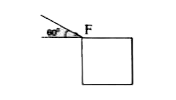A 10√3 kg box has to move up an inclined slope of 60∘ to the horizontal at a uniform velocity of 5 ms−1 If the frictional force retarding the motion is 150N, the minimum force applied parallel to inclined plane to move up is (g=10 ms−2)
300×2√3N
300×√32N
300N
150N
The correct Answer is:C
To solve the problem step by step, we will analyze the forces acting on the box as it moves up the inclined plane.
Step 1: Identify the Given Data
- Mass of the box, m=10√3kg
- Angle of incline, θ=60∘
- Uniform velocity, v=5ms−1
- Frictional force, ffriction=150N
- Acceleration due to gravity, g=10ms−2
Step 2: Calculate the Weight of the Box
The weight W of the box can be calculated using the formula:
W=m⋅g
Substituting the values:
W=10√3⋅10=100√3N
Step 3: Resolve the Weight into Components
The weight can be resolved into two components:
1. Perpendicular to the incline: W_{\perpendicular} = W \cos \theta
2. Parallel to the incline: W∥=Wsinθ
Calculating these components:
- W_{\perpendicular} = 100\sqrt{3} \cdot \cos 60^\circ = 100\sqrt{3} \cdot \frac{1}{2} = 50\sqrt{3} \, \text{N}
- W∥=100√3⋅sin60∘=100√3⋅√32=150N
Step 4: Apply Newton's Second Law for Uniform Velocity
Since the box is moving at a uniform velocity, the net force acting along the incline must be zero:
Fapplied−W∥−ffriction=0
Rearranging gives:
Fapplied=W∥+ffriction
Step 5: Substitute the Values
Substituting the calculated values:
Fapplied=150N+150N=300N
Step 6: Calculate the Minimum Force Required
To find the minimum force F applied parallel to the incline, we need to consider the angle:
Fcosθ=Fapplied
Substituting θ=60∘:
F⋅12=300N
Thus,
F=300⋅2=600N
Final Answer
The minimum force applied parallel to the inclined plane to move the box up is:
600N
- Mass of the box, m=10√3kg
- Angle of incline, θ=60∘
- Uniform velocity, v=5ms−1
- Frictional force, ffriction=150N
- Acceleration due to gravity, g=10ms−2
The weight W of the box can be calculated using the formula:
W=m⋅g
Substituting the values:
W=10√3⋅10=100√3N
The weight can be resolved into two components:
1. Perpendicular to the incline: W_{\perpendicular} = W \cos \theta
2. Parallel to the incline: W∥=Wsinθ
- W_{\perpendicular} = 100\sqrt{3} \cdot \cos 60^\circ = 100\sqrt{3} \cdot \frac{1}{2} = 50\sqrt{3} \, \text{N}
- W∥=100√3⋅sin60∘=100√3⋅√32=150N
Since the box is moving at a uniform velocity, the net force acting along the incline must be zero:
Fapplied−W∥−ffriction=0
Rearranging gives:
Fapplied=W∥+ffriction
Substituting the calculated values:
Fapplied=150N+150N=300N
To find the minimum force F applied parallel to the incline, we need to consider the angle:
Fcosθ=Fapplied
Substituting θ=60∘:
F⋅12=300N
Thus,
F=300⋅2=600N
The minimum force applied parallel to the inclined plane to move the box up is:
600N
Topper's Solved these Questions
- LAWS OF MOTIONBOOK - AAKASH SERIESCHAPTER - LAWS OF MOTIONEXERCISE - EXERCISE - II
136 Videos
- GEOMETRICAL OPTICSBOOK - AAKASH SERIESCHAPTER - GEOMETRICAL OPTICSEXERCISE - ADDITIONAL PRACTICE EXERCISE (LEVEL-II PRACTICE SHEET (ADVANCED) INTEGER TYPE QUESTIONS)
10 Videos
- LOGIC GATESBOOK - AAKASH SERIESCHAPTER - LOGIC GATESEXERCISE - Exercise (Very Short Answer)
10 Videos
Similar Questions
A 10√3 kg box has to move up an inclined slope of 60∘ to the horizontal at a uniform velocity of 5 ms−1 If the frictional force retarding the motion is 150N, the minimum force applied parallel to inclined plane to move up is (g=10 ms−2)
View SolutionA block of weight 1 N rests on a inclined plane of inclination θ with the horizontal. The coefficient of friction between the block and the inclined plane is μ. The minimum force that has to be applied parallel to the inclined plane to make the body just move up the plane is
View SolutionA wooden box of mass 8kg slides down an inclined plane of inclination 30∘ to the horizontal with a constant acceleration of 0.4ms−2 What is the force of friction between the box and inclined plane ? (g=10m/s2) .
View SolutionA wooden box of mass 8kg slides down an inclined plane of inclination 30∘ to the horizontal with a constant acceleration of 0.4ms−2 What is the force of friction between the box and inclined plane ? (g=10m/s2) .
View SolutionA block of mass √3kg is kept on a frictional surface with μ=12√3. The minimum force to be applied as shown to move the block is

View SolutionAn object is moving on a plane surface with uniform velocity 10ms−1 in presence of a force 10N. The frictional force between the object and the surface is
View SolutionAn elevator that can carry a maximum load of 1500 kg (elvator+ passengers) is moving up with a constant speed of 2 ms−1. The frictional force opposing the motion is 3000 N. Find the minmum power delvered by the motor to the elevator in watts as well as in horse power (g=10ms−2)
View SolutionA block rests on a rough inclined plane making an angle of 30∘ with horizontal. The coefficient of static friction between the block and inclined plane is 0.8 . If the frictional force on the block is 10N, the mass of the block in kg is (g=10m/s2)
View SolutionA ball is projected from the bottom of an inclined plane of inclination 30∘, with a velocity of 30ms−1, at an angle of 30∘ with the inclined plane. If g=10ms−2 , then the range of the ball on given inclined plane is
View SolutionA particle is fired horizontally form an inclined plane of inclination 30∘ with horizontal with speed 50ms−1. If g=10ms−2 , the range measured along the incline is
View Solution
